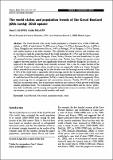Por favor, use este identificador para citar o enlazar a este item:
http://hdl.handle.net/10261/76688COMPARTIR / EXPORTAR:
 SHARE
BASE SHARE
BASE
|
|
| Visualizar otros formatos: MARC | Dublin Core | RDF | ORE | MODS | METS | DIDL | DATACITE | |

| Título: | The world status and population trends of the Great Bustard (Otis tarda): 2010 update |
Autor: | Alonso López, Juan C. CSIC ORCID ; Palacín, Carlos CSIC ORCID | Palabras clave: | Great Bustard (Otis tarda) Population trends Status |
Fecha de publicación: | 2010 | Editor: | Chinese Birds | Citación: | Chinese Birds 1(2):141–147 (2010) | Resumen: | The Great Bustard (Otis tarda) world population is estimated to be 44100–57000 individuals in 2010, of which about 57–70% occur in Spain, 15–25% in European Russia, 4–10% in China, Mongolia and south-eastern Russia, 3–4% in Portugal, 3% in Hungary, 1–2% in Turkey, and smaller numbers in ten other countries. The reliability of current censuses and estimates may be described as high for a large fraction of the world population (67–75%), and low for the remaining 25–33% (including Russia, Mongolia, China, Turkey, Ukraine, Iran and Kazakhstan). In spite of continued declines reported for some countries (e.g., Turkey, Iran, China), the present survey suggests that total numbers have not significantly decreased worldwide during the last decade, as opposed to the globally declining trend currently assumed. This is due to a large fraction of the world total living in countries whose overall surveys are apparently stable (e.g., Spain, Portugal), after a noticeable recovery during the last few decades once the hunting ban was established. Only 6–10% of the world total is apparently still decreasing, mostly due to agricultural intensification, other causes of habitat degradation, and locally, also illegal hunting and collision with power lines. A small fraction of the world population (3–4%), is clearly (Germany, Austria) or apparently (Hungary) increasing, due to management and conservation measures. Finally, 19–22% of the world total has an uncertain status, due to inaccurate current or past censuses which prevent establishing reliable population trends. We recommend 1) keeping conservation efforts and the species’ protection status worldwide, and 2) carrying out urgently nation-wide surveys in countries with low quality estimates, in order to confirm world numbers and trends. | Descripción: | 7 páginas y 2 tables | URI: | http://hdl.handle.net/10261/76688 | ISSN: | 1674-7674 |
| Aparece en las colecciones: | (MNCN) Artículos |
Ficheros en este ítem:
| Fichero | Descripción | Tamaño | Formato | |
|---|---|---|---|---|
| Alonso & Palacín Chinese Birds (2010).pdf | 317,52 kB | Adobe PDF |  Visualizar/Abrir |
CORE Recommender
Page view(s)
544
checked on 16-abr-2024
Download(s)
520
checked on 16-abr-2024
Google ScholarTM
Check
NOTA: Los ítems de Digital.CSIC están protegidos por copyright, con todos los derechos reservados, a menos que se indique lo contrario.
